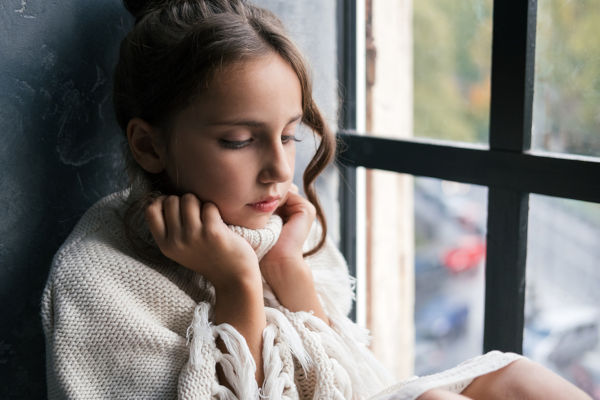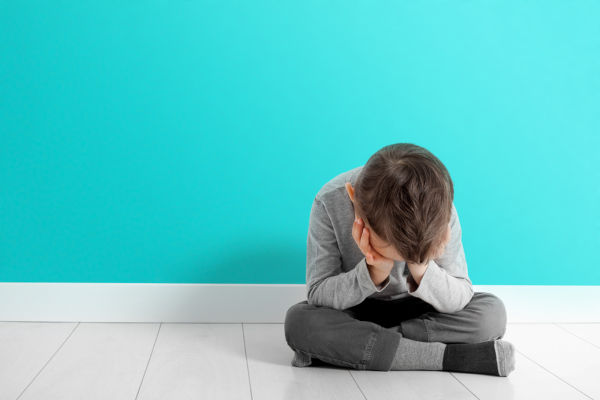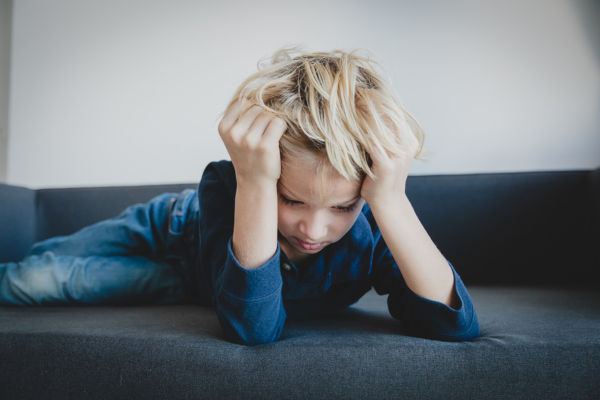Anxiety is a normal part of human behaviour. It’s a fundamental aspect of our “flight or fight” response. Back in the days when we lived in caves and were regularly chased by lions, tigers, and indeed, bears, anxiety helped us survive through ensuring we didn’t take unnecessary risks and remained on alert for danger.
Anxiety in children is common, and part of growing up. Children might be afraid of the dark, or worried about starting a new school, or too fearful to take the stabilisers off a bike. All of this is a normal part of childhood, but when that anxiety is impossible to overcome, and when it stops us from taking part in activities and joining in the fun, it becomes a problem.
What Causes Anxiety In Children?

Whilst anxiety is a normal part of growing up, anxiety that is having an impact on your child’s day to day activities and social interactions can be harmful to their mental health. Often, it is difficult to identify why a child is struggling with anxiety, but there are certain factors that can contribute to the problem.
Having a close family member who suffers from an anxiety disorder is thought to be one factor. It is possible that genetics may make a child more prone to anxiety. In addition, anxiety can be a learned behaviour, so if the child regularly witnesses a parent or older sibling being anxious, they may learn to become afraid, as well.
Anxiety may also be caused by events and situations that the child witnesses. It could be a family or pet bereavement that brings home the idea of death and loss to a child. It might be a car accident, that, even if it was only a minor “bump”, could still have been a very frightening experience for the child. A child who overhears something terrible happening on the news, such as a bombing or plane crash, might become anxious about it happening to them.
Anxiety in children can even be triggered by situations that you might think were fairly benign, such as a grandparent going into hospital for a routine operation. Often, anxiety in children is caused when children witness events, but lack the capacity to fully understand the situation and context. They may use their imagination to fill in those gaps in understanding, resulting in them becoming more fearful.
How To Spot Anxiety In Young Children

Whilst adults and teenagers are able to express their feelings through words, children often find it much harder to do so. They may not fully understand what they are feeling and lack the ability to put those feelings into words. Anxiety in children can manifest in a number of different ways, and many of the symptoms may be attributed to other disorders or illnesses, or even be dismissed as a sign of their immaturity. For this reason, anxiety in children can easily be missed.
Physical Symptoms Of Anxiety In Children
It’s worth bearing in mind that anxiety has a physical response in the body. When we encounter a scary or stressful situation, our natural “flight or fight” response is triggered, releasing stress hormones into the body that raise the heart rate, tense the muscles, and reduces blood flow to your stomach.
If your child regularly complains of stomach ache, you might be wondering if they have developed a food intolerance, and whilst this may be the case, it is also worth considering if anxiety could be the cause. Stomach ache is one of the most common complaints that children with anxiety have. The physical changes that the stress hormones create can cause issues with their digestive system. Their stomach muscles may cramp, they may feel sick or even be sick, they may develop acid reflux that leads to a tight feeling in their chest (another possible complaint your child may make), and they may develop diarrhoea. As a result of these changes to their digestive system, your anxious child may lose their appetite. You may even notice a pattern, for example, before school they may refuse to eat breakfast.
You may also notice that your child is fidgety, restless, and rarely sits still. It might be tempted to think that they have a disorder, such as ADHD, and whilst that is a possibility, it could also be that anxiety is the cause. The stress hormones make our muscles tense and our heart beat faster, so that we are ready to run, or fight if needed. If a child is anxious, they may be experiencing that physical response throughout most, if not all of the day, making it much harder for them to relax and sit still. Come bedtime, those same hormones make it harder to fall asleep, so your anxious child may be suffering from insomnia.
If your child regularly complains of headaches, this too may be caused by anxiety. Again, muscle tension and hormonal changes can cause both tension headaches and migraines. If your child is experiencing these symptoms on a regular basis it is, of course, always best to get them checked by a medical professional to rule out any other illnesses and disorders.
Emotional & Behavioural Symptoms Of Anxiety In Young Children
Sometimes anxiety is missed in children because their behaviours are often misinterpreted as being caused by something else. A child might be described as “immature”, “sensitive”, or even “naughty”. Sometimes the behaviour of an anxious child might cause the parent to consider other disorders, such as autism, ADHD, OCD, or Oppositional Defiant Disorder.
Of course, a diagnosis is impossible without a medical professional, which is why if your child is exhibiting any of these symptoms on a regular basis and these are having a negative impact on their well-being, you should seek professional help.
An anxious child may:
- Become rigid in their routine, so that when a routine changes unexpectedly they may have a meltdown.
- May have regular emotional and angry outbursts.
- Be sensitive to very loud noises, such as hand-dryers in public toilets.
- Refuse to join in with other children at parties and social activities.
- Refuse to go to school.
- Refuse to do homework.
- Be very a clingy. A toddler might become extremely distressed when away from their parent. A child might refuse to leave your side at a play centre or party.
- Have regular nightmares, possibly involving the death of a parent or becoming lost.
- Be generally tearful and overly sensitive.
- Have difficulty in concentrating.
- Constantly seek reassurance.
- Refuse to try new things, even when they see other children trying it.
How To Help An Anxious Child

If your child’s anxiety is severe, it’s important to seek help from your GP. They may refer your child onto the Child and Adolescent Mental Health Service (CAMHS) in your area for an assessment and treatment, or they may be able to signpost you to other local organisations and charities that can offer support.
There are lots of steps you can take at home to support your child with anxiety. You can enable them to develop a healthy approach to stressful situations through a number of ways.
1. Try Some Mindfulness & Meditation Techniques
Mindfulness is a useful tool for helping to manage anxiety. When we are anxious, we tend to have all of our focus turned inwards, and mindfulness seeks to reverse that. A simple activity to do with children is to get them to lie down and ask them to tense and then relax each part of their body in turn, starting with their toes and then working up the body through their legs, hips, stomach, shoulders, arms and hands. You could make it more fun by getting them to pretend they are trying to find a hidden superpower in their body.
When out and about you could set them challenges that gets them to focus on the world around them, rather than on their own thoughts. For example, ask them to count how many red cars they spot, or get them to look for ladybirds in the plants they pass.
The Headspace app has a section just for kids with activities they can try. You could also look to sign your child up to a class that includes mindfulness or meditation, such as a children’s Yoga class.
2. Keep Your Home Calm
Make sure your home is a place where your child can feel safe and calm. Avoid conflict with other adults in front of your child. Board games can help your family bond together and provide a calm way to spend time together.
Avoid watching the news (or listening to it on the radio) when your child is present. You might think they are not paying attention, but the chances are that they are absorbing information. The news tends to focus on negative stories, so it can be easy for a child to feel like the world is a scary place after watching the average news bulletin.
3. Model Good Behaviour
If you have anxiety yourself then there is a good chance that your child will pick up on this and learn to become fearful through watching you. Avoiding displaying anxiety in front of your child is easier said than done, and it is demoralising to think that your own mental health problem is having a negative impact on your child, but there are strategies you can implement to deal with this issue.
Try to adopt a calm manner, even when you are feeling anxious. Think about how your face appears and the words that you use. If you are struggling to remain calm, tell your child you need to use the bathroom and take a couple of minutes to practice breathing deeply.
Talk to your child about your own fears. We’re not suggesting that you should tell them all your financial woes, or the problems with your relationships, but you can talk to them about why you have reacted in a certain way. For example, if your child ran off in the supermarket you may have shouted at them when you found them. You could explain to them when you are calmer that the reason you shouted was because you were very worried that they might have got lost. This teaches your child that it’s ok to feel worried and gives you the opportunity to discuss with your child how best to cope these with these worries.
Be mindful of little ears listening in. If you do have anxiety then you should avoid discussing your fears in front of your children, as there is a good chance they will listen in and may adopt those fears as their own.
4. Be Empathetic
”Don’t worry, there’s nothing to be scared about” is a typical response that we as parents might use when our children share their fears or anxiety, but it’s not really that helpful. It is quite dismissive of a genuine emotion and doesn’t address the fact that your child lacks the tools to overcome the anxiety and get to a position where they don’t need to worry.
Instead, try and be empathetic. For example, your child might be worried about sports day because they know they are unlikely to do very well compared to their peers. You could try saying “I know you are scared about going to sports day today, but that’s ok. I used to get scared to about my sports day, but it was actually quite fun when I got there. If you do feel scared you can look out for me in the crowd and I will blow you a good luck kiss.”
5. Avoid Avoidance
If certain situations trigger your child’s anxiety, then you may be tempted to avoid them all together. For example, if your child is anxious about going to a party, you could tell them that they do not need to go. However, it would be counter-productive, since it could just teach your child that every time they are upset about something, you will simply remove them from the situation.
Instead, try talking to your child about their fears. Don’t tell them that they will have an amazing time, or win the race, or that everyone will want to be their friend, because that will inevitably lead to disappointment and increased anxiety if that doesn’t happen. Focus on your child’s ability to get through a difficult time. Tell them that you know they are brave enough to face the situation, and that you will be waiting to give them a cuddle when it’s over.
6. Talk To Your Child About Scary Situations, But Not Too Soon
Your child might have an event coming up that could cause them some anxiety, such as a vaccination at the doctor’s, a trip to the dentist, or a visit to see an important relative in hospital. It’s important to talk to your child about what is going to happen at this event, so that they are not surprised by anything, which can add to their anxiety.
However, you don’t want to do this too soon. Avoid saying something like, “Oh, it’s your vaccination appointment next week, I expect you will be very brave though,” as this simply gives your child an entire week to dwell on the issue. Aim to talk to your child just before you need to leave, to reduce the amount of time they have to think about how it might be scary.
7. Talk To Your Child About Anxiety
If your child is old enough to understand, you could try talking to them about the changes that anxiety can cause in their bodies. You don’t have to go into great detail about the science behind hormonal changes, but simply explain to them how when we worry, our worries make our heads and stomachs hurt and make us feel poorly.
This can help in two ways. It can reduce the possibility that your child will become anxious about the physical symptoms of anxiety, perhaps believing that they are very poorly, and thus perpetuating the cycle. It can also help your child to recognise when they are feeling anxious, and this in turn can help them to seek help when they need it.
8. Make A Worry Box
Spend some time with your child to make a worry box. Your child can decorate it however they choose and then when they are worried about something either you or your child can write that worry down on a piece of paper and place it in the box.
Explain to your child that by putting it in the box it means that we don’t have to think about it anymore, because the box is keeping the worry safe. Once a week, you and your child can open the worry box and read the worries. The chances are that the worries have become something that is no longer a problem, or it wasn’t as bad as your child previously thought.
9. Give Your Child Plenty Of Downtime
With after school clubs, homework, and sports club activities at the weekend, it’s easy for today’s kids to become overwhelmed and exhausted. Many parents, and teachers, will tell you that the phenomenon “end-of-term-itis” certainly exists, with primary children in particular becoming increasingly emotional and tired towards the end of term. What’s more, in the age of social media, sometimes we can pile too much onto our children in order to seem like perfect parents that turn everything into an educational opportunity.
With that in mind, make sure your child gets plenty of down time. Remember that it is sometimes ok, even necessary, to spend the day in our pyjamas doing very little. And, when you do go out, keep it simple. A walk in the woods or a trip to the local park will help refresh and invigorate your child, which will have huge benefits to their mental and physical health.




